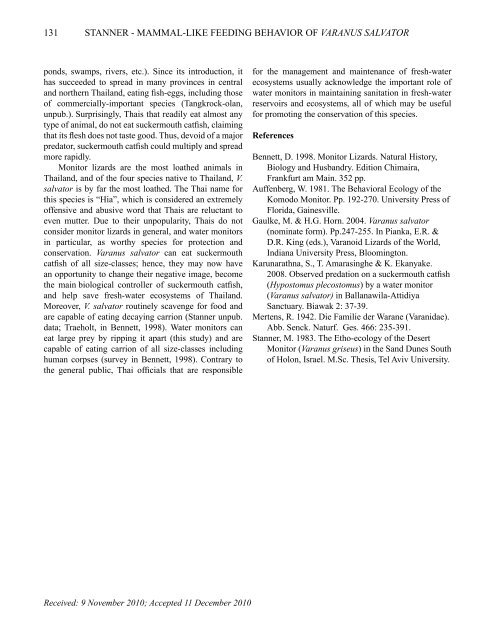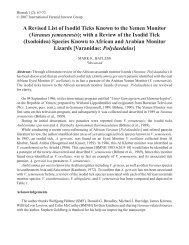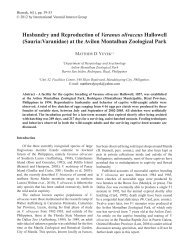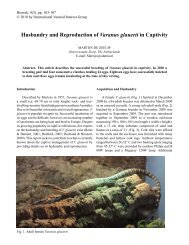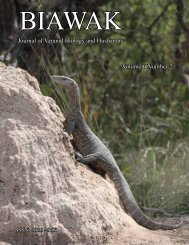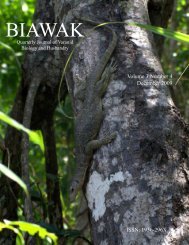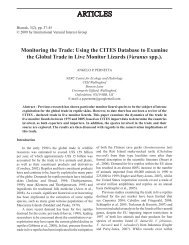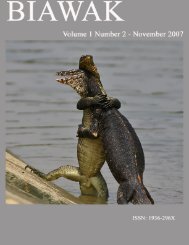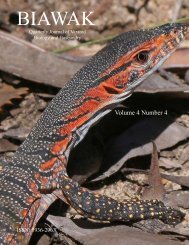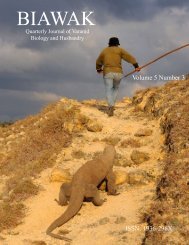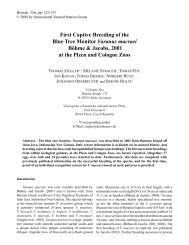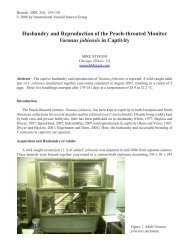BIAWAK - International Varanid Interest Group
BIAWAK - International Varanid Interest Group
BIAWAK - International Varanid Interest Group
- No tags were found...
You also want an ePaper? Increase the reach of your titles
YUMPU automatically turns print PDFs into web optimized ePapers that Google loves.
131<br />
STANNER - MAMMAL-LIKE FEEDING BEHAVIOR OF VARANUS SALVATOR<br />
ponds, swamps, rivers, etc.). Since its introduction, it<br />
has succeeded to spread in many provinces in central<br />
and northern Thailand, eating fish-eggs, including those<br />
of commercially-important species (Tangkrock-olan,<br />
unpub.). Surprisingly, Thais that readily eat almost any<br />
type of animal, do not eat suckermouth catfish, claiming<br />
that its flesh does not taste good. Thus, devoid of a major<br />
predator, suckermouth catfish could multiply and spread<br />
more rapidly.<br />
Monitor lizards are the most loathed animals in<br />
Thailand, and of the four species native to Thailand, V.<br />
salvator is by far the most loathed. The Thai name for<br />
this species is “Hia”, which is considered an extremely<br />
offensive and abusive word that Thais are reluctant to<br />
even mutter. Due to their unpopularity, Thais do not<br />
consider monitor lizards in general, and water monitors<br />
in particular, as worthy species for protection and<br />
conservation. Varanus salvator can eat suckermouth<br />
catfish of all size-classes; hence, they may now have<br />
an opportunity to change their negative image, become<br />
the main biological controller of suckermouth catfish,<br />
and help save fresh-water ecosystems of Thailand.<br />
Moreover, V. salvator routinely scavenge for food and<br />
are capable of eating decaying carrion (Stanner unpub.<br />
data; Traeholt, in Bennett, 1998). Water monitors can<br />
eat large prey by ripping it apart (this study) and are<br />
capable of eating carrion of all size-classes including<br />
human corpses (survey in Bennett, 1998). Contrary to<br />
the general public, Thai officials that are responsible<br />
for the management and maintenance of fresh-water<br />
ecosystems usually acknowledge the important role of<br />
water monitors in maintaining sanitation in fresh-water<br />
reservoirs and ecosystems, all of which may be useful<br />
for promoting the conservation of this species.<br />
References<br />
Bennett, D. 1998. Monitor Lizards. Natural History,<br />
Biology and Husbandry. Edition Chimaira,<br />
Frankfurt am Main. 352 pp.<br />
Auffenberg, W. 1981. The Behavioral Ecology of the<br />
Komodo Monitor. Pp. 192-270. University Press of<br />
Florida, Gainesville.<br />
Gaulke, M. & H.G. Horn. 2004. Varanus salvator<br />
(nominate form). Pp.247-255. In Pianka, E.R. &<br />
D.R. King (eds.), Varanoid Lizards of the World,<br />
Indiana University Press, Bloomington.<br />
Karunarathna, S., T. Amarasinghe & K. Ekanyake.<br />
2008. Observed predation on a suckermouth catfish<br />
(Hypostomus plecostomus) by a water monitor<br />
(Varanus salvator) in Ballanawila-Attidiya<br />
Sanctuary. Biawak 2: 37-39.<br />
Mertens, R. 1942. Die Familie der Warane (<strong>Varanid</strong>ae).<br />
Abb. Senck. Naturf. Ges. 466: 235-391.<br />
Stanner, M. 1983. The Etho-ecology of the Desert<br />
Monitor (Varanus griseus) in the Sand Dunes South<br />
of Holon, Israel. M.Sc. Thesis, Tel Aviv University.<br />
Received: 9 November 2010; Accepted 11 December 2010


